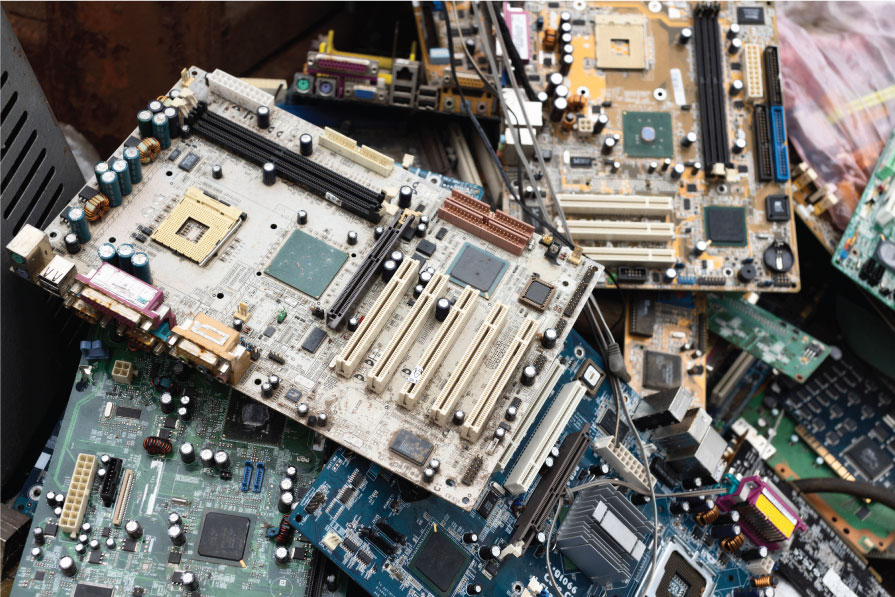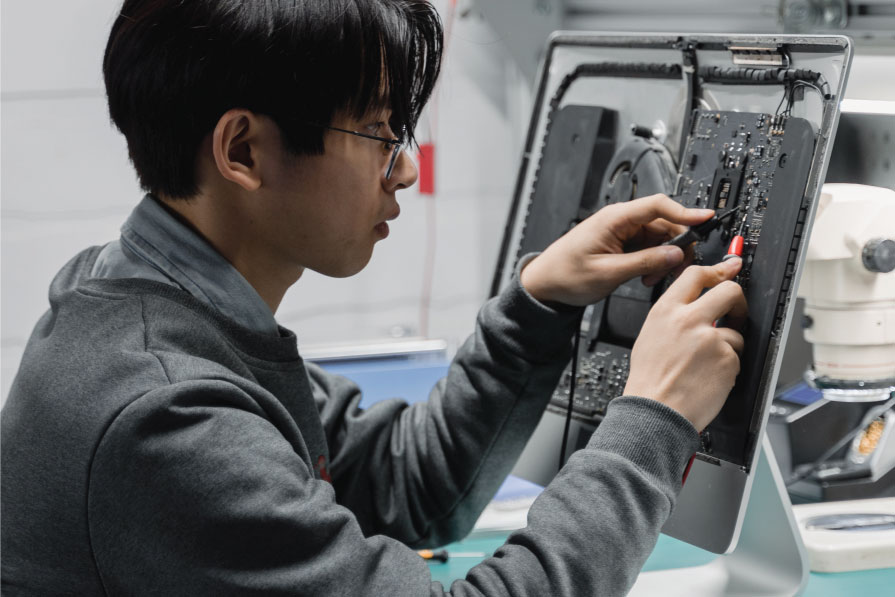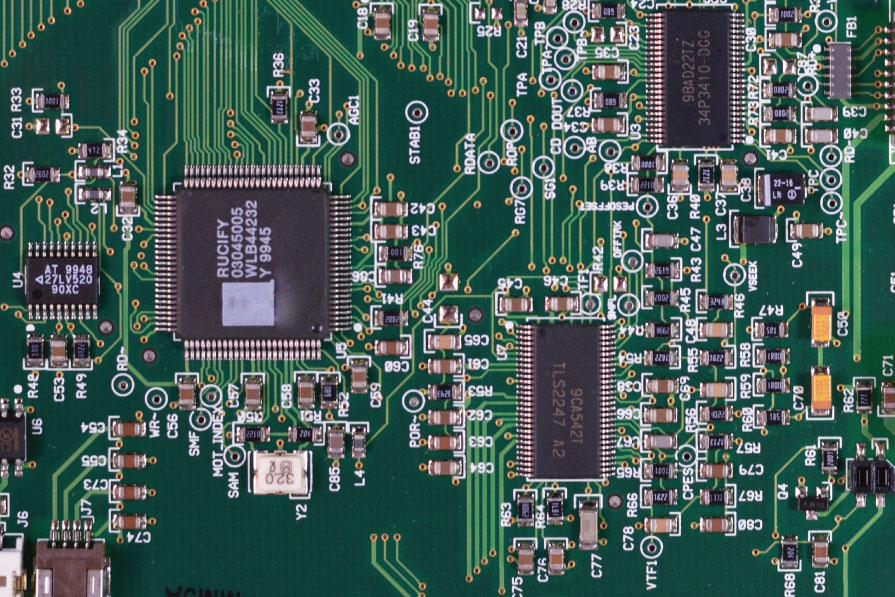53.6 million metric tons. That’s over 118 billion pounds. No, I’m not talking about the weight of the Great Wall China (which is 116 billion pounds, in case you’re wondering). I’m talking about the weighty problem of e-waste. The United Nations claims the world produced 118,167,773,000 pounds of e-waste or 53.6 million metric tons in 2019 alone.
That’s heavier than all of the adults in Europe combined, and this waste isn’t the same as the trillions of pounds of trash generated the world. E-waste contains a slew of harmful chemicals and materials, like mercury, which the UN says accounts for about 110,000 pounds of undocumented waste every year.
I sat down with a few experts in the field of electronics design, sustainability, and repair to figure out why we have such a big e-waste problem and more importantly, what we can do to solve it.
But to understand our e-waste problem, we have to look past the waste itself.
Device life cycle, and a circular economy

If you pay attention to big tech events, you’ve undoubtedly heard about the acicular economy. If you’re unfamiliar, the idea is simple enough: Instead of having an end of life for devices, they’re reintroduced, recycled, or reused to keep the life cycle going. You know, like a circle.
That’s something Michelle Chua Prasert, senior director of innovation and sustainability at Intel, is focused on. The idea of a circular economy is great in theory — just keep using devices that are already around but it has a big problem. A lot of people either don’t want to get rid of their old devices, or they don’t know how.
How do we facilitate someone handing down their PC at first life to someone else, Chuaprasert asked when I talked with her. The options are there. I think it’s a matter of how do we all motivate each other, right, to take advantage of [recycling programs] or donate in whichever way is easy for us.
There are a growing number of ways to either recycle of resell your old devices, even if they aren’t perfect. Best Buy and Staples offer in-store recycling programs, and major device manufacturers like Apple offer trade-in programs. Sites like BackMarket also offer a secondhand marketplace tailored for electronics. And Intel says an increasing number of people are buying secondhand since the coronavirus pandemic emerged.
Melissa Gregg is a senior principal engineer at Intel, who headed up the Intel EVO line before moving on to aid efforts to create more sustainable designs. Gregg told me that the pandemic offered an opportunity to have that conversation, perhaps even for the first time, if whether people always need a new PC.
It’s no secret that the demand for computers grew immensely during 2020, as the exodus from the office pushed workers into their homes and schools transitioned to a remote learning model. Add on top of that the chip shortage, and it was difficult for a lot of people to buy a new PC. In some ways, it still is.
The UN says only 17.4% of e-waste was collected and recycled in 2019. And the U.S. is one of the worst countries in the world when it comes to recycling.
The positive outcome, according to Intel, is that hopeful buyers started seeking out secondhand options. For all of those other people who still need computers, recirculating them, and having access to platforms that make that easy for people to pass on their devices, to me, is a really positive outcome of a pretty bad situation, Gregg said.
So, problem solved, right? Everyone trades in or recycles their old devices, we don’t dump or burn any more toxic e-waste, and round and round the circle goes.
But it’s not working
Best Buy has offered recycling for the past 12 years, and although the company says it has recycled 2 billion pounds of electronics since 2009, that’s only a microscopic fraction of the total e-waste the world produces in a single year. In total, the UN says only 17.4% of e-waste was collected and recycled in 2019. And the U.S. is one of the worst countries in the world when it comes to recycling.
Owners of devices have a responsibility to ensure that those devices don’t end up in a landfill. But that only addresses a small part of the problem with how electronics impact the environment.
Billowing smog
Manufacturing. If you’re concerned about the impact e-waste has on the environment, manufacturing should terrify you. It’s true that a circular economy is good for everyone, but manufacturing is where “the big, ugly stuff is done,” according to Gay Gordon-Byrne, executive director of The Repair Association.
Compared to usage, manufacturing accounts for a much more significant portion of a device’s carbon footprint. Microsoft says that around 78% of a Surface device’s carbon footprint comes from manufacturing. A report from 2018 says that between 85% and 95% of annual carbon emissions from phones is due to manufacturing.
It’s the dirty secret of the electronics that power our world today. Recycling your devices helps, and voluntary ecolabels like EPEAT and Energy Star give manufacturers a goal post for designing more energy-efficient devices. But the fact of the matter is, when you get rid of one device, the manufacturer is ready to make a new one.

“That creates two big problems,” according to Gordon-Byrne. “One is you’ve now got an e-waste problem you didn’t have, and on the other side, you also have a manufacturing problem where really, the big, ugly stuff is done. You know, all the mining, all the terrible worker experiences, all of the pollution. That’s actually all manufacturing.”
This isn’t something the Microsofts and Intels of the world have shied away from. It’s easy and justified to point the finger at manufacturers, but that’s not a solution. Given our reliance on devices today, we can’t just stop making them — but manufacturers can take steps to reduce their environmental impact.
The idea is dematerialization, which Chuaprasert says is a “really big” deal. Take a motherboard, for example. “The motherboard itself inside the PC is one of the higher carbon footprint areas,” Chuaprasert said. “You can make a really big difference if you can shrink the motherboard.”
Chuaprasert even pointed to circuit board cutting. Often, devices come with motherboards cut in a precise way to fit a particular form factor, but taking cutting out of the picture can make for more efficient manufacturing. “Just having more rectangular shapes instead of cutouts goes a long way for reducing the carbon footprint.”

